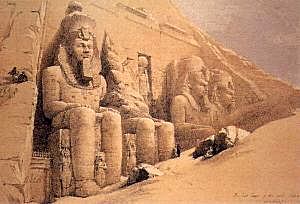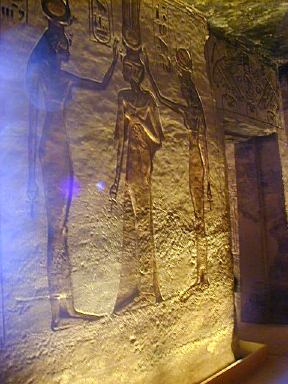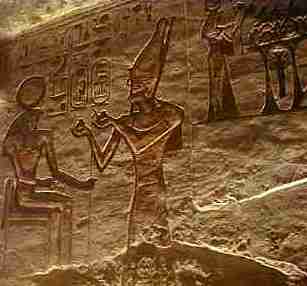Abu Simbel's two temples are unique among those of ancient Egypt. Unlike cult temples such as Luxor and Karnak (as opposed to mortuary temples), which were added to (and subtracted from) by many kings through many centuries, Abu Simbel was constructed by a single pharaoh, Ramesses II. And, though, like other temples, the Great Temple was dedicated to a Triad, Amun-Re (the deity of Thebes), Re-Herakhty (Heliopolis) and Ptah (Memphis), a fourth deity, who took pride of place, was Ramesses himself.
The four huge seated sandstone statues (one was severely damaged by an earthquake in 1248 BCE and could not be repaired) that form the facade provide space between them for much smaller figures of wives and children. The small figure above the door is that of Re-Herakhy with "the goddess Maat by his left leg and the hieroglyphic sign for User by his right, so that the image of the god may be read as the name 'User-Maat-Re' [one of Ramesses' names] (Joyce Tyldesley, Ramesses: Egypt's Greatest Pharaoh, p. 105).
Ptah, Amun-Re, Ramesses, Re-Herakhty. |
Ramesses as mummyform Osiris. In Egyptian theology, the living pharaoh was the embodiment of Horus, the son of Isis and Osiris. But when he died the king became Osiris, lord of the underworld. Consequently, when Ramesses II, or any other pharaoh had himself depicted in the mummy form as shown here, he was claiming to be divine while still alive.
|
 | The sands of time literally covered Abu Simbel when worship of the god Ramesses II stopped a few years after his death and it was not discovered again in modern times until, in 1813, Johann Burckhardt came across strange figures in the sand. The temples were still largely buried in 1838 when the Scotch artist David Roberts painted the great temple (left). A far worse catastrophe was averted in 1964-68 when, as a result of a successful international effort to raise sufficient funds and the cooperation of major museums, Abu Simbel and a number of other Nubian temples were saved from the rising waters of Lake Nasser behind the Aswan High Dam. For Abu Simbel that meant cutting the entire temple into managable pieces and fitting them back together within a concrete dome on higher ground. That is the Abu Simbel we see today. Read more about it here. |

A few steps to the north of the Great Temple is the smaller one dedicated to the goddess Hathor or, more accurately, to Ramesses' favorite wife, Nefertari, in the form of Hathor. It was not only unusual it was almost unprecedented for a Egyptian king to honor his wife in this way ("almost" because of the relationship between Akhenaton and his wife, Nefertiti, almost 100 years earlier). Nevertheless, four of the six statues fronting the Small Temple are of Ramesses; the other two are of Nefertari wearing the horns that identify her as Hathor.
Let's step inside. . . .
 |  | One of the six Hathor columns. The text beneath Hathor tells stories of Nefertari and Ramses. Next, the delicate feminine figures of Nefertari and Hathor engage in a ritual. And then there is Ramesses offering to the falcon-headed god, Horus.
 |